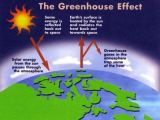European researchers from EPICA (European Project for Ice Coring in Antarctica) have extended the greenhouse gas record back to 650,000 years before the present. They have studied the air bubbles trapped in the ice of Antarctica and mapped the levels of the greenhouse gases (carbon dioxide, methane, nitrous oxide). The ice core contains hundreds of thousands of years-worth of atmospheric air samples within tiny bubbles trapped in the ice. The air bubbles form when snowflakes fall, and they contain a record of global greenhouse gas concentrations.
The analysis of the data showed that today's rising atmospheric carbon dioxide concentration (which has a 9-26% contribution to greenhouse effect), is already 27 percent higher than its highest recorded level during the last 650,000 years. "We have added another piece of information showing that the timescales on which humans have changed the composition of the atmosphere are extremely short compared to the natural time cycles of the climate system," Thomas Stocker of the Physics Institute of the University of Bern, Switzerland, said.
However, the greenhouse gas record during past ice ages also provides indirect evidence for abrupt climate change in the past, the authors found. This suggests that after all abrupt climatic events on time scales relevant to societies may be common features of the last climatic cycles.
The new ice core analysis provides some interesting insights on our present interglacial warm period. One of the warm periods now documented, which occurred between 420,000 and 400,000 years ago, was found to be relatively similar to the present one. This analog warm period is known as Marine Isotope Stage 11 or MIS 11.
The similarities between our current warm period and MIS 11 are primarily due to a similar configuration of the orbits of the Earth around the Sun: the key driver of ice age cycles is the relative positions of the Earth and Sun. "MIS 11 shows us that the climate system can indeed reside in a warm period for 20,000 or 30,000 years, something that we can't say based on the last three warm phases which are no longer than about 10,000 years each," said Stocker.
We are currently about 10,000 years into our current warm period. They also documented, although in less detail, MIS 13 and 15 - two warm periods more distant than MIS 11. The fact that MIS 13 and 15 were also long warm periods contrasts the argument scientists have made in the past suggesting that our current warm period is exceptionally long.
Thanks to the methane and carbon dioxide records from EPICA, this study has also made available new insights important for understanding the impact early human activities (such as land clearing and rice culture) had on atmospheric greenhouse gas concentrations, the topic of several recent studies. The new record shows that natural variability can result in significant oscillations in greenhouse gases during some interglacial periods and thus lowers the probability that early human activities were responsible for the greenhouse gas variability seen as early as 10,000 years ago.

 14 DAY TRIAL //
14 DAY TRIAL // 
